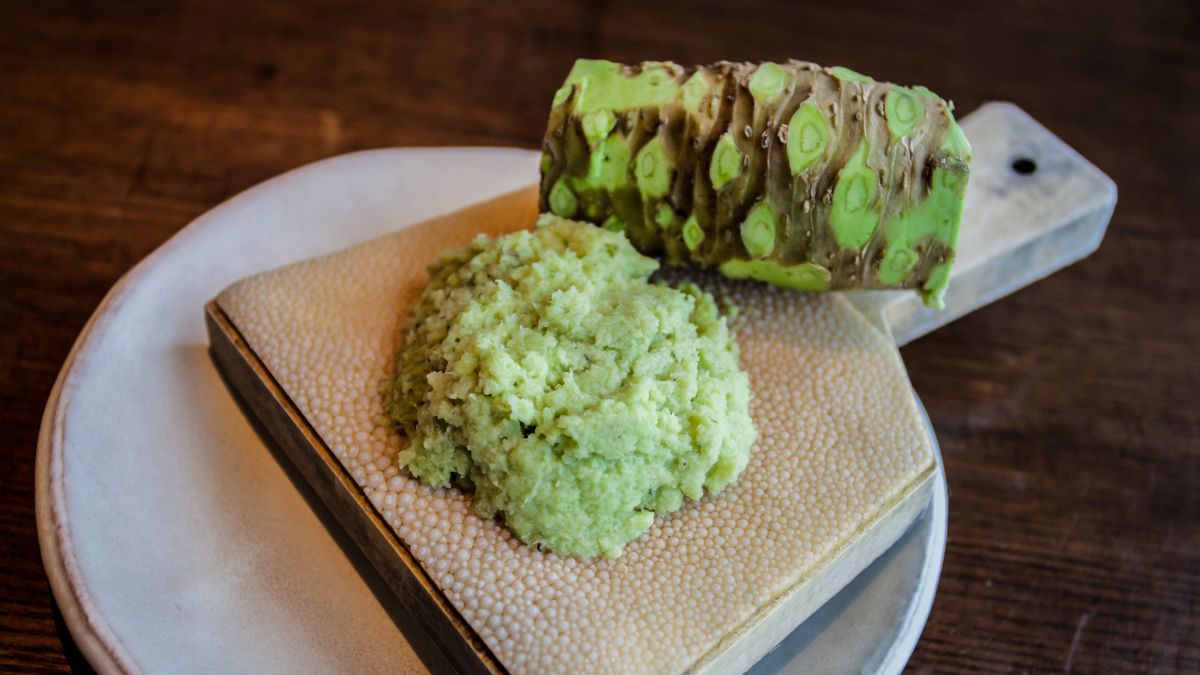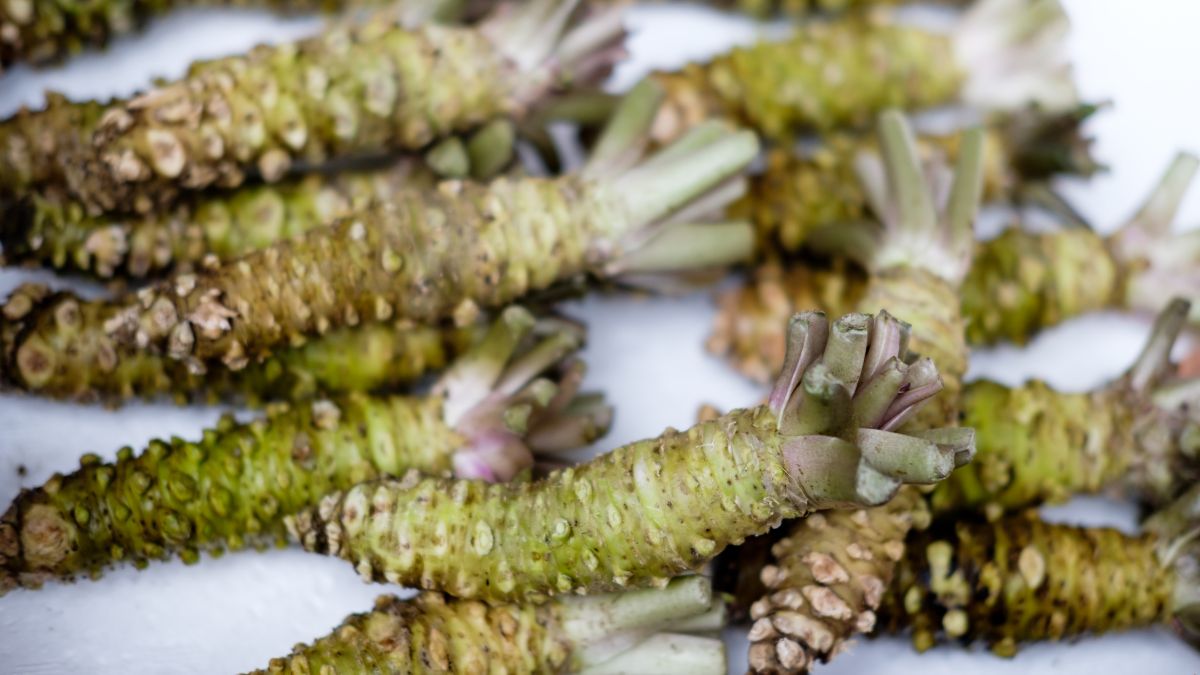Is Wasabi Spicy? Here’s How Much Exactly!

Wasabi comes from the Japanese-native plant Wasabia Japonica from the radish family and is also known as Japanese horseradish. Wasabi is a known paste characterized by its hot and fiery flavor, burning your mouth and nose. It is a frequent ingredient in sushi and a welcomed addition to dips and sauces. However, wasabi is not for everyone, especially if you are not crazy in love with the hot and spicy flavors. Still, some would consider wasabi perfectly tolerable, while others would need the fire department to help them with the burn. So, how spicy is wasabi?
Wasabi is somewhere between burning hot and spicy. Spicy implies the presence of several spices in large amounts, which is not precisely how wasabi works. Wasabi creates a tingly and mouth-numbing sensation, and it burns the nose just like the palate.
Wasabi is very spicy yet very delicious, and it finds a place in many recipes as an integral ingredient and flavor-giving meal addition. However, it can make your eyes water and stiffen your mouth if you aren’t an experienced wasabi fan or you are trying it for the first time. In the following paragraphs, I will explain how spicy wasabi is and where it gets its spiciness from.
How Spicy Is Wasabi?
The first thing you need to know about wasabi is that there is authentic and fake wasabi. Since the plant is grown in some parts of Japan, authentic wasabi is expensive and not available, so the supermarket wasabi is likely to be fake.
Fake wasabi is mostly made of horseradish and mustard plants, which fall in the same family as Wasabia Japonica and tend to have similar flavors. However, the store-bought wasabi also contains thickeners such as cornstarch and flour, which impact the taste. The fake wasabi gives the authentic wasabi somewhat of a bad name, as it is overly spicy and hot.
On the other hand, Authentic wasabi is a paste made from the Wasabia Japonica plant and has a clean flavor, which is not spicy in the traditional sense. The authentic wasabi flavor is intense and strong but not spicy.
It creates a mouth-watering sensation that is more of a tingle than an actual burn and tends to numb the palate. Even though it is strong, the wasabi flavor is delicate, and you will definitely notice the natural and fresh taste of the authentic plant.
The fake wasabi flavor, the one that is more commonly known, is the one that makes you think that wasabi is the hottest thing under the sun. The fake wasabi is known to be overly spicy and is not as pure as the authentic one.
Because of its combination of flavors, the fake wasabi gravitates toward spicy rather than strong and is therefore seen as too intense. The authentic wasabi flavor is stimulating but not spicy.
The primary purpose of authentic wasabi is to stimulate your appetite and accentuate the other flavors involved, not to become the main characteristic of the dish. Conversely, the fake wasabi flavor is prevalent in the combination, therefore making you think that the wasabi is the spiciest thing on the table or in your meal.
Another thing that plays a massive role in how spicy the wasabi is is how long it has been sitting out. When it comes to authentic wasabi, you need to have it freshly made, preferably in the first 15 minutes after it has been made. The longer the wasabi sits out, the more the flavor decreases.
So, if you like more expressive flavors and you like your wasabi more on the stronger side, don’t let it out for too long. If you have wasabi made a while ago, it will still be delicious, but it won’t be as spicy and strong as freshly made.
What Makes Wasabi Spicy?
Wasabi is a Japanese culture as well as a culinary thing. It has been initially used to accentuate raw fish flavors, a known Japanese delicacy. Wasabi was never intended to use as a spice or a flavor-giving ingredient but merely as a flavor accentuating food.
As such, wasabi is not spicy in itself. Traditionally, it is made by grating the wasabi and turning it into a paste. Nowadays, the paste wasabi that is available to buy is fake wasabi, made of horseradish, mustard, and food coloring.
Therefore, they are too spicy and overwhelming, while real wasabi is not of that kind. Nevertheless, real wasabi is strong due to a chemical it contains called allyl isothiocyanate, to which the body reacts very specifically.
Namely, it isn’t the taste that makes you tear up; it is your body’s reaction to the chemical. You feel the chemical through your wasabi receptor that has a protective reflex against the allyl isothiocyanate. So, your body tries to protect you again this chemical by tearing and creating mucus in your nose so that you release the chemical.
You can find allyl isothiocyanate also in horseradish, mustard, cauliflower, and cabbage. However, it isn’t equally contained everywhere, but if you think about it, nibbling on raw cabbage has made your eyes well up once or twice.
So, in a nutshell, it isn’t the wasabi that is too spicy, but it is how the body perceives the chemical and how it reacts to it. In any case, genuine wasabi is far more elegant than fake wasabi.
Why Wasabi Burns Your Nose?
The chemical I mentioned earlier, the allyl isothiocyanate contained in the wasabi, causes your nose to burn. As you chew the wasabi, the chemical travels to the back of your mouth and into the nasal cavity.
As the allyl isothiocyanate arrives in the nose, it irritates the nose and sinuses, causing a burning sensation. Therefore, you notice that you feel a bit more mucous in your nose than usual. That’s a protective response of the body against the chemical.
The allyl isothiocyanate isn’t a chemical harmful to you, but it is a new substance the body recognizes and wants to remove. That’s why your nose gets runny and your eyes well up when you have wasabi.
How Hot Is Wasabi Compared to Peppers?
Even though wasabi is pretty out there, it isn’t as hot as you might think compared to some types of peppers. The primary purpose of peppers isn’t to amplify the dish but to bring taste and garnish the dish. While you need to combine wasabi, you don’t have to combine peppers, and you can nibble on a pepper without pairing it.
Therefore, the pepper hotness is expectedly stronger than that of the wasabi. However, not all peppers are hotter than wasabi. For example, the banana and bell peppers are sweet-tasting and cannot even begin to compare with the wasabi.
Jalapeño peppers are somewhat hotter than wasabi. However, this comparison is not so clean-cut because there are other factors you need to consider. The jalapeño peppers are not just hot but also very flavorful, which is why they seem hotter.
Suppose you single out the hotness of the jalapeño and the wasabi, eliminating the other flavors involved. In that case, it may turn out that the wasabi is as hot as the jalapeño peppers.
Combined with habanero peppers, wasabi is not even close to as hot as these fiery vegetables. Ghost peppers are also much hotter than wasabi, and the Carolina reaper peppers are like you’ve swollen hell itself. Compared to the Carolina reaper peppers, wasabi may even feel sugary sweet.
How Hot Is Wasabi Compared to Jalapeño?
Jalapeño and wasabi are equally strong rivals when it comes to hot food. Both can make your eyes tear up, your nose run, and your forehead sweat. Neither can go unnoticed, and they are not for everyone.
Both jalapeño and wasabi are highly nutritious, offering a wide range of vitamins, such as C, A, B, D, and E, as well as nutrients such as magnesium and folate. Of the two, the jalapeño pepper is richer in nutrients overall, but that doesn’t make wasabi nutrient-poor.
Jalapeño is hotter than wasabi, but there are other things to consider before drawing a permanent conclusion. First of all, the jalapeño pepper has flavor. It is used as an addition to salads, as a spice, as a part of a spice blend, and as a flavor-giving condiment.
Even though the jalapeño pepper is hot, that is not its sole feature, and its main purpose is to flavor the dish. On the other hand, the wasabi is fresh, neutral-tasting, and strong. The primary purpose of the wasabi is to enhance the other flavors it is combined with.
Therefore, when you initially taste wasabi and jalapeño peppers, the jalapeño will seem hotter because of the other flavors it contains that amplify the hotness of the jalapeño.
If you isolate only the hotness of the jalapeño and compare it to the wasabi taste, they may even be equal. However, singling out only one flavor feature for this comparison is impossible and is therefore only left to assume that jalapeño and wasabi are equally hot.
Nevertheless, even if you decide that the jalapeño pepper is hotter than the wasabi, the difference is not that big. Still, it is a different kind of hot. While you will have a tingling and numb sensation in your mouth and on your tongue from the wasabi, you will feel a strong burning sensation from the jalapeño.
The wasabi flavor doesn’t stay that long after swallowing the wasabi and is easily washable with milk or water. The jalapeño flavor tends to be longer-lasting, and you cannot wash it away with a few sips of milk or water.
What Is Wasabi Made Of?
Wasabi is made of the plant Wasabia Japonica, which is the Japanese version of horseradish. This plant is very hard to get a hold of, as it is native to Japan and not on the entire territory of the country, but in some areas. The Wasabia Japonica plant needs specific conditions to grow and is primarily cultivated in highlands with less sun exposure.
Because it is pretty specific, the Wasabia Japonica is not widespread worldwide, so pure and genuine wasabi is extremely hard to find. Traditionally, wasabi is grated Wasabia Japonica and turned into paste. It is served fresh, and in its pure form, it is refreshing and toned down.
The wasabi available in the stores intended for broad use is not authentic wasabi but a mixture of horseradish, mustard, and green food coloring. This wasabi is far more aggressive than genuine wasabi and tends to overwhelm the dish. The genuine wasabi accentuates the already existing flavors in the dish without dominating it.

Is Wasabi Good for You?
Using wasabi in your kitchen can bring several benefits. Its extract can reduce the risk of food poisoning and some other stomach-related issues. Some studies showed that wasabi leaf can help with losing weight by preventing the formation of fat cells. [1]
Due to the small amount of iron, wasabi can lower the risk of developing anemia, a condition of the reduced amount of healthy red blood cells. [2] Wasabi also has some vitamin E, calcium and potassium. It is low in carbs, fats, sugars, and cholesterol. [3]
Because it creates a burn in the nose, this plant is also an excellent sinus cleanser.
